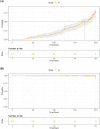High seroprevalence of severe acute respiratory syndrome coronavirus 2 among healthcare workers in Yaoundé, Cameroon after the first wave of Covid-19 pandemic and associated factors
- PMID: 38342486
- PMCID: PMC10859237
- DOI: 10.1111/irv.13239
High seroprevalence of severe acute respiratory syndrome coronavirus 2 among healthcare workers in Yaoundé, Cameroon after the first wave of Covid-19 pandemic and associated factors
Abstract
Background: Healthcare workers (HWs) are at a high risk of exposure to emerging health threats. Following the first wave of the coronavirus disease 2019 pandemic in Cameroon, we explored the presence and persistence of naturally acquired antibodies against severe acute respiratory syndrome coronavirus 2 (SARS-CoV-2) and the factors associated with seropositivity in HWs.
Methods: Staff at two referral hospitals in Yaoundé or two Health District Hospitals in Obala and Mbalmayo were included in a 6-month prospective cohort analysis or cross-sectional survey, respectively. Seroprevalence and associated factors were determined, and Kaplan-Meier curves and Cox proportional hazards models were used to assess antibody persistence or positive seroconversion over time.
Results: From August 2020 to March 2021, 426 HWs (median age: 31 years, interquartile range: 27-37 years; 66.4% female) were enrolled. The overall seroprevalence of anti-SARS-CoV-2 antibodies was 54.0% (95% confidence interval [CI]: 49.1-58.8) and was significantly different between study sites (p = 0.04). Of the 216 HWs included in the 6-month cohort, 109 (50.5%) HWs were seropositive at inclusion; the probability of persistent antibodies or of becoming seropositive was 93.8% (95% CI: 84.2-100) and 78.9% (95% CI: 61.7-88.4), respectively. Seroconversion was associated with study site and occupation but not with infection prevention and control (IPC) practices.
Conclusions: We observed high seroprevalence of SARS-CoV-2 antibody and seroconversion among HWs associated with occupational risk. This suggests low compliance to the COVID-19 control measures. Continued training and implementation of IPC measures and accelerated preparedness are needed to better tackle future threats.
Keywords: Cameroon; SARS-CoV-2 infection antibody testing; antibody persistence; health personnel; seroepidemiologic studies.
© 2024 The Authors. Influenza and Other Respiratory Viruses published by John Wiley & Sons Ltd.
Conflict of interest statement
The authors have no relevant financial or non‐financial interests to disclose.
Figures

Similar articles
-
High seroprevalence of anti-SARS-CoV-2 antibodies among Ethiopian healthcare workers.BMC Infect Dis. 2022 Mar 16;22(1):261. doi: 10.1186/s12879-022-07247-z. BMC Infect Dis. 2022. PMID: 35296265 Free PMC article.
-
Seroprevalence of SARS-CoV-2 antibodies and associated risk factors during the second wave of infection in a university community in Cameroon.Influenza Other Respir Viruses. 2023 Nov 12;17(11):e13222. doi: 10.1111/irv.13222. eCollection 2023 Nov. Influenza Other Respir Viruses. 2023. PMID: 37964992 Free PMC article.
-
Comprehensive infection control measures prevent hospital-acquired severe acute respiratory syndrome coronavirus 2 infection: A single-center prospective cohort study and seroprevalence survey.PLoS One. 2021 Oct 11;16(10):e0257513. doi: 10.1371/journal.pone.0257513. eCollection 2021. PLoS One. 2021. PMID: 34634076 Free PMC article.
-
Seroprevalence of SARS-CoV-2 antibodies and associated factors in healthcare workers: a systematic review and meta-analysis.J Hosp Infect. 2021 Feb;108:120-134. doi: 10.1016/j.jhin.2020.11.008. Epub 2020 Nov 16. J Hosp Infect. 2021. PMID: 33212126 Free PMC article.
-
Occupational health protection for health workers during the coronavirus disease 2019 (COVID-19) pandemic: 6P-approach in China.Glob Health J. 2021 Dec;5(4):215-219. doi: 10.1016/j.glohj.2021.11.007. Epub 2021 Nov 25. Glob Health J. 2021. PMID: 34849270 Free PMC article. Review.
References
-
- Haldane V, De Foo C, Abdalla SM, et al. Health systems resilience in managing the COVID‐19 pandemic: lessons from 28 countries. Nat Med. 2021;27:964‐980. - PubMed
-
- Weekly epidemiological update on COVID‐19‐15 February 2022. Accessed 18 April 2023. Available at: https://www.who.int/publications/m/item/weekly-epidemiological-update-on...
-
- Sorbello M, El‐Boghdadly K, Di Giacinto I, et al. The Italian coronavirus disease 2019 outbreak: recommendations from clinical practice. Anaesthesia. 2020;75:724‐732. - PubMed
Publication types
MeSH terms
Substances
Grants and funding
LinkOut - more resources
Full Text Sources
Medical
Miscellaneous

